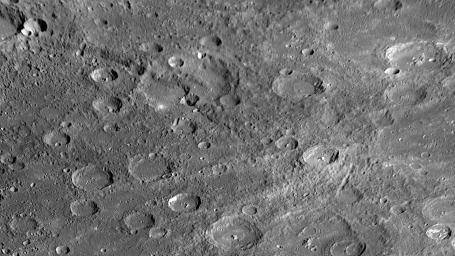
|
Long Scarps on Mercury Tell of the Planet’s Unique History
- Click the image above for a larger view
- Full-Res JPEG (3840 x 2160) (1.6 MB)
- Full-Res TIFF (3840 x 2160) (8.3 MB)
Caption:
Extending from the left edge of this image diagonally toward the lower right corner is a long scarp (cliff) face. This scarp runs through a large ancient crater in the center of the frame and was seen for the first time during MESSENGER's second Mercury flyby . Planetary geologists use the Latin term "rupes" for scarps on Mercury . Scarps such as this one have been identified all over the planet. The presence of many long and high scarps suggests a history for Mercury that is unlike that of any of the other planets in the Solar System. These giant scarps are believed to have formed when Mercury's interior cooled and the entire planet contracted slightly as a result, causing the surface rocks to fracture and some blocks of crust to thrust over others along great faults. Determining the geometry of such scarps on Mercury and information on the times that deformation occurred can thus be used to understand the thermal history of the planet. Next year, when the MESSENGER spacecraft is in orbit around Mercury, MDIS will acquire for the first time global imaging coverage of Mercury's surface with lighting conditions optimal for identifying such scarps.
Date Acquired:
October 6, 2008
Instrument:
Narrow Angle Camera (NAC) of the Mercury Dual Imaging System (MDIS)
Scale:
The large crater crosscut by the scarp is approximately 110 kilometers (70 miles) in diameter.
Background Info:
These images are from MESSENGER, a NASA Discovery mission to conduct the first orbital study of the innermost planet, Mercury. For information regarding the use of images, see the MESSENGER image use policy .
Cataloging Keywords:
| Name | Value | Additional Values |
|---|---|---|
| Target | Mercury | |
| System | ||
| Target Type | Planet | |
| Mission | MESSENGER | |
| Instrument Host | MESSENGER | |
| Host Type | Orbiter | |
| Instrument | Mercury Dual Imaging System (MDIS) | |
| Detector | Narrow Angle Camera (NAC) | |
| Extra Keywords | Crater, Grayscale, Thermal | |
| Acquisition Date | ||
| Release Date | 2010-09-28 | |
| Date in Caption | 2008-10-06 | |
| Image Credit | NASA/Johns Hopkins University Applied Physics Laboratory/Carnegie Institution of Washington | |
| Source | photojournal.jpl.nasa.gov/catalog/PIA13477 | |
| Identifier | PIA13477 | |
